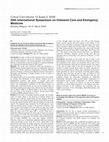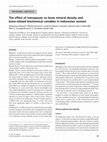Papers by Maryantoro Oemardi

Critical Care, 2008
all 10 cities including the rural areas of the province of Kerman. All data were finally analyzed... more all 10 cities including the rural areas of the province of Kerman. All data were finally analyzed by SPSS software (version 11.5). Results On the basis of recorded statistical analysis, the mortality cases of human rabies in the province of Kerman during one decade was 10 persons (eight males and two females). One-half of them (50%) were bitten by dogs and the others (50%) by foxes. Among the reported deaths, 40% were from Kahnooj county (Jiroft region). The reported data indicated that 21,546 persons were bitten by animals during 10 years in the province of Kerman. The mean of age of the people who were bitten by dogs was 24.80 years (SD = ±14.6), while the mean age of the people who were bitten by foxes was 57.25 years (SD = ±1.50). There was a significant difference between the mean age of these two groups of the people (P < 0.05). The most frequent rate of injured people was reported in the age group 10-19 years old and the frequency rate of males (76.00%) was more than females (24.00%). Therefore, there was a statistically significant difference between males and females in this study (P < 0.01). About 60% of all persons that were bitten by animals were from rural areas and 40% of them were from urban areas (P < 0.05). Among the people who were bitten and injured by animals during one decade in the province of Kerman, 85.70% of them were not treated by the rabies prophylaxis treatment regimen. Among all of them who were bitten by animals, 50% were injured through hands and feet, 40%
To assess the effect of ultraviolet-B (UVB) from sun exposure on vitamin D3 [25(OH)D] status and ... more To assess the effect of ultraviolet-B (UVB) from sun exposure on vitamin D3 [25(OH)D] status and parathyroid hormone (PTH) concentration in elderly Indonesian women.

Clinical Endocrinology, 2007
Objective To determine the effects of menopause on bone-related variables in Indonesian women an... more Objective To determine the effects of menopause on bone-related variables in Indonesian women and to compare them with corresponding data in Caucasian Australian women.Design A study of bone-related variables in women aged 45–55 years in Jakarta compared with corresponding historical data from Caucasian Australian women.Measurements Dietary intakes, bone mineral density (BMD) and calcium-related variables in blood and urine.Results Dietary calcium, phosphorus and protein intakes were significantly lower in the women from Jakarta than in those from Adelaide (all P < 0·001), probably because of lower milk consumption, but energy intake was similar in the two cities. Indonesian women were shorter and lighter than Australian women (P < 0·001) but had a comparable body mass index (BMI). The Indonesians also had a lower spinal BMD than the Australians but this was accounted for by the differences in height and weight between the two populations. The differences in serum and urinary calcium and phosphate and serum alkaline phosphatase across the menopause were comparable in Indonesian and Australian women but creatinine excretion was 25% lower in Jakarta than in Adelaide (P < 0·001) and this was probably sufficient to account for higher ratios of some urinary solutes to urinary creatinine in the Indonesians. Serum 25-hydroxyvitamin D (25OHD) levels were significantly lower (P < 0·001) and serum PTH levels significantly higher (P = 0·0045) in Jakarta than in Adelaide.Conclusions The differences in bone-related biochemical variables across the menopause were similar in the two populations, but calcium and protein intake and urine creatinine were lower in Indonesian than in Australian women. Serum 25OHD was lower and PTH higher in the Indonesian women, probably because of their darker skin, their practice of avoiding direct sunlight and the heavy atmospheric pollution in Jakarta.

Uploads
Papers by Maryantoro Oemardi